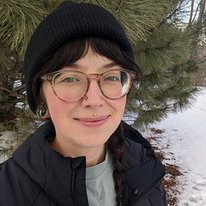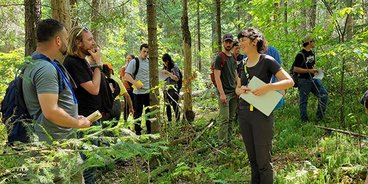Catherine Glenn-Stone is a junior in the Forest and Natural Resource Management (FNRM) Bachelor of Science major program on the Forest Ecosystem Management and Conservation (FEMC) track. Her path to us is a meandering trail with many noteworthy and inspiring stops along the way, always generally moving forward despite not knowing exactly where the end point might be. She has Minnesota roots, grew up in Bayport, and went to high school in Stillwater before moving up to Duluth and enrolling at Lake Superior College (LSC). Living so close to the dramatic natural environment of the North Shore made an impression on Catherine. She took a forest ecology course at LSC and realized that perhaps she could have a career in natural resources, even if she wasn’t quite sure of all of the details at the time. After finishing an Associate of Arts degree, she enrolled at the University of Minnesota’s Horticulture program, which she enjoyed, but things didn’t quite fit—like a shoe that’s the right size but feels askew somehow.
She transferred to Minneapolis Community and Technical College and earned an Herbalism certificate. “We had labs and made tinctures and lotions with different blends of herbs that could be used for treatments—we weren’t actually treating people, of course. We’d write reports on specific plants and herbs called materia medicas about what the plants were used for in different cultures like Indigenous medicines, Traditional Chinese Medicine, Ayurvedic Medicine, and the like. It was focused on Western Herbalism, but I took traditional plant biology classes, too.”
She kept moving forward and worked in food service for a few years at restaurants and then a bakery in Minneapolis. The service industry was meaningful and respectable work with memorable colleagues, but she found herself feeling stagnant making the same muffins and cookies each day. She wondered about a more stable career, one with health benefits, and maybe the possibility of retirement someday. She wanted to grow. “I wanted to be outside more and do something meaningful, something that helps people, something that contributes to protecting the environment.”
Catherine came back to the University of Minnesota and enrolled in the FNRM program. It was an easy decision. Some of her family were close, and she liked the St. Paul campus from her time in Horticulture. It was a peaceful place, a kind of hidden utopian garden. She integrated herself quickly, and credits the diversity of backgrounds among students in the program. Some of them come straight from high school and head through college in four years, and others are transfer students who bring a variety of lived experiences with them.
“College is much easier when you go back or go as an adult. I already know who I am; whereas, when you’re 18 or 20, you’re still learning who you are and how to be independent. I have a lot more focus now, and I’m doing things differently than I did before. I was really shy, but now I participate in things like the Forestry Club—not necessarily all the time, but sometimes, which I wouldn’t have done when I was younger.”
Catherine joined the CFANS mentorship program and got paired up with Dr. Eli Sagor, an Extension Specialist and Adjunct Faculty member in the department. Eli advised her on the value of an SAF accredited degree and what that would mean for her career. “He got me to think about what I’m interested in, pushed me to follow it, and connected me to the people I needed to meet who were doing that type of work.”
She’s excited by the interconnectedness of forest ecosystems, of ecosystems in general, and science more broadly. “I wasn’t thinking about how loggers and forest managers think about a responsible tree harvest, but there’s so much advanced planning and guidelines and rules and knowing how to do things effectively to achieve specific goals. They have so much knowledge that we don’t see from the outside. Coming in, I thought, ‘Okay, they just go in, and they cut the trees down,’ but there are a lot of different ways to cut down trees and manage a stand. It’s a lot more complex than most people understand.”
These days her path is more clearly defined, but still open-ended. She’d like to go to graduate school and perhaps become a silviculturist after that. “I’d like to work with a team to figure out how to manage a forest. I’d be the one coming up with a plan to achieve a certain goal for the forest, and that planning part is really interesting to me. Maybe that kind of sounds boring to some people, but it’s exciting to me. Writing a prescription to manage a forest sustainably is like a puzzle. I’d like to do more research, too, to just keep on contributing and learning and growing.”
The Forest Scene newsletter is published biannually in the spring and fall, featuring stories and updates from the Department of Forest Resources. Readers can download issue 27 of Forest Scene as an interactive PDF that is fully tagged and compatible with most screen readers, or read the individual stories here in a web-based format.



